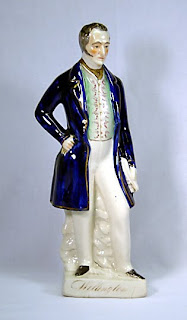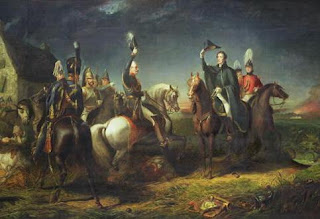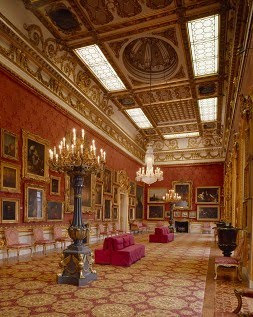Lord only knows how, but Vicky, Brooke and I also found time to visit Gray’s Antiques Market in London. It’s a warren of little shops selling all manner of stuff. We found a military specialist who had a samll, framed, woven silk Waterloo commemorative picture that he wanted L650 for (!?!?!) and assorted other incidentally Wellington stuff that was likewise priced outrageously. As Vicky and I were walking out, Brooke came to tell us that she’d found another shop nearby where Artie-facts were going for a reasonable sum. Off we raced and Vicky found a smaller version of the Wellington portrait I’d gotten at Storey’s, while I found a framed color cartoon of the Duke done in 1831 for McLean’s Magazine. In fact, Brooke got so good at sussing out Artie-facts this trip, Vicky and I nicknamed her “Scout.” (You’ll be seeing photos of Vicky’s Wellington portrait in future posts).
 On Wednesday evening, Brooke and I were walking towards Leicester Square in order to visit Chinatown for a Peking duck dinner and happened to be passing when I glanced up and saw the street sign that read “Cecil Court.” I pulled Brooke aside and glanced at the shops. This time, the only one that was open was Mark Sullivan Antiques, where I’d seen the Wellington figurine in the window (at left). In we went and were greeted by Dave and Mark. The inside of the shop is an absolute treasure trove and Dave proved to be knowledgeable about both antiques and the Duke of Wellington. He pulled out all the items he had on hand related to the Duke. It seems the present Duke of Wellington had just been in on the Saturday. You don’t say!? And what, pray tell, does the Duke of Wellington collect? Items related to the first Duke of Wellington, of course. Really. I thought this a bit rich. I mean to say, hasn’t the man already got enough first hand Artie-facts scattered about Strathfield Saye and Apsely House – not to mention in the cellars and attics? What about the statue in the window, I asked Dave, why hadn’t the Duke bought that on Saturday? Because, Dave explained, he’d only gotten it in on Sunday and put it in the window on the following Monday. We then chatted a bit more before Dave tried to stump me by throwing out Artie one-liners. “Sparrow hawks, ma’am,” Dave offered. “Said to Queen Victoria, Great Exhibition of 1851,” I responded, unruffled. “Publish and be damned,” said Dave. “Harriet Wilson,” I replied on a yawn. “By God, man, so you have!” said Dave. “Please,” I sneered, “Too easy. Artie’s response upon Paget’s telling him he’d just lost his leg.”
On Wednesday evening, Brooke and I were walking towards Leicester Square in order to visit Chinatown for a Peking duck dinner and happened to be passing when I glanced up and saw the street sign that read “Cecil Court.” I pulled Brooke aside and glanced at the shops. This time, the only one that was open was Mark Sullivan Antiques, where I’d seen the Wellington figurine in the window (at left). In we went and were greeted by Dave and Mark. The inside of the shop is an absolute treasure trove and Dave proved to be knowledgeable about both antiques and the Duke of Wellington. He pulled out all the items he had on hand related to the Duke. It seems the present Duke of Wellington had just been in on the Saturday. You don’t say!? And what, pray tell, does the Duke of Wellington collect? Items related to the first Duke of Wellington, of course. Really. I thought this a bit rich. I mean to say, hasn’t the man already got enough first hand Artie-facts scattered about Strathfield Saye and Apsely House – not to mention in the cellars and attics? What about the statue in the window, I asked Dave, why hadn’t the Duke bought that on Saturday? Because, Dave explained, he’d only gotten it in on Sunday and put it in the window on the following Monday. We then chatted a bit more before Dave tried to stump me by throwing out Artie one-liners. “Sparrow hawks, ma’am,” Dave offered. “Said to Queen Victoria, Great Exhibition of 1851,” I responded, unruffled. “Publish and be damned,” said Dave. “Harriet Wilson,” I replied on a yawn. “By God, man, so you have!” said Dave. “Please,” I sneered, “Too easy. Artie’s response upon Paget’s telling him he’d just lost his leg.”  During our Waterloo tour we made many stops at the site of the iconic battlefields involved in the engagement. At one site, our tour coach parked and our guide shuffled everyone off the bus to see Napoleon’s view point. It was freezing, the wind was blowing and, really, I thought I’d pass on another look at another empty field. However, as he was exiting the bus, our guide threw out the fact that across the street stood La Belle Alliance. What!? I watched as the group walked away in the opposite direction. Wait! Where are you going? Are ya kidding me? La Belle Alliance – Napoleon’s headquarters but, infinitely more important, the site where Wellington and Blucher met after the Battle of Waterloo to acknowledge their victory. Cold and wind aside, I was off the bus like a shot and across the street. Honestly, the place looks just as it must have in 1815. I’d show you, but I was too shocked to even think of taking a picture. The wide, wooden gates were thrown open, the Inn and the courtyard were there for anyone to see – and I was the only one in sight.
During our Waterloo tour we made many stops at the site of the iconic battlefields involved in the engagement. At one site, our tour coach parked and our guide shuffled everyone off the bus to see Napoleon’s view point. It was freezing, the wind was blowing and, really, I thought I’d pass on another look at another empty field. However, as he was exiting the bus, our guide threw out the fact that across the street stood La Belle Alliance. What!? I watched as the group walked away in the opposite direction. Wait! Where are you going? Are ya kidding me? La Belle Alliance – Napoleon’s headquarters but, infinitely more important, the site where Wellington and Blucher met after the Battle of Waterloo to acknowledge their victory. Cold and wind aside, I was off the bus like a shot and across the street. Honestly, the place looks just as it must have in 1815. I’d show you, but I was too shocked to even think of taking a picture. The wide, wooden gates were thrown open, the Inn and the courtyard were there for anyone to see – and I was the only one in sight. (Yes, that is my finger in front of the lens)
Well, the first room you enter is the gift shop. And it was absolutely chock full of . . . . Napoleon stuff. No, I’m not kidding. Believe me, I searched every item in the joint for something Artie related. Nada. Nil. Nuttin’ Honey. And all of the display signs are in French. As far as I could tell, there was no indication as to which room Gordon had died in. Upstairs, there’s a room where there’s a desk and seated behind the desk is a wax figure that looks like Wellington if Wellington had been a crackhead who had been on a four day bender. I’m assuming this was the room Wellington used as an office, but who knows?
The redeeming portion of the visit was what lay out back – Paget’s leg. Okay, okay, it’s really only the spot where Paget’s leg once lay. It seems that when he died, his family had the leg disinterred, sent to England and buried with the rest of Paget – or Lord Uxbridge, who became the Marquess of Anglesey. But still . . . Paget’s leg. I mean everyone who was anyone who travelled to Waterloo after the Battle made a pilgrimage to see the grave. And now I was there, too.
led our intentions of doing all things Artie this trip over. We’re already thinking about our next visit, which will take place sometime between now and 2015, when I/we attend the next Wellington Conference held in Southampton, England (will also be doing Walmer Castle and Stratfield Saye). And 2012 is obviously out, as we don’t want to have to contend with Olympic Fever in London. In the meantime, watch this space for many more posts related to our Tour.

















